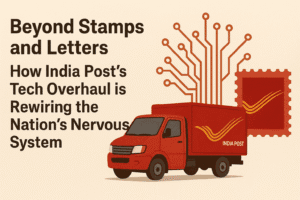Beyond Stamps and Letters: How India Post’s Tech Overhaul is Rewiring the Nation’s Nervous System
India Post has embarked on a revolutionary, nationwide tech modernization, investing ₹5,800 crore to digitally transform its vast network of 1.64 lakh post offices. This initiative moves far beyond faster mail, strategically repositioning the historic institution as a agile, citizen-centric logistics powerhouse. Developed entirely in-house, the new system enables real-time tracking and flexible delivery options, including evenings and Sundays.
Crucially, it empowers small businesses and artisans by seamlessly integrating with national platforms like ONDC, bridging the gap between remote producers and the digital marketplace. This overhaul strengthens the entire e-commerce ecosystem by solving the last-mile delivery problem to the most isolated areas. Ultimately, it’s a profound leap toward digital inclusion, ensuring the benefits of the modern economy reach every single pin code in India.

Beyond Stamps and Letters: How India Post’s Tech Overhaul is Rewiring the Nation’s Nervous System
For generations, the neighbourhood post office has been a symbol of steady, if sometimes slow, connection. But in a stunningly swift three-month blitz, that iconic institution has been thrust into the 21st century. The recent nationwide rollout of India Post’s Advanced Postal Technology (APT) isn’t just an IT upgrade; it’s a complete rewiring of the country’s largest physical network, with profound implications for every citizen and business.
Union Minister Jyotiraditya Scindia aptly called it a “historic leap,” and the numbers are staggering: a ₹5,800-crore investment modernizing 1.64 lakh post offices. But beyond the headlines and the budget lies a deeper story about access, opportunity, and a strategic bet on India’s own technological prowess.
The “Why”: More Than Just Faster Mail
The driving force behind this transformation isn’t merely about delivering letters more quickly. It’s a recognition of a fundamental shift in the Indian economy. As e-commerce explodes, logistics have become the backbone of growth. Yet, private players often find the “last mile” to remote and rural areas logistically challenging and economically unviable.
This is where India Post’s unmatched asset comes in: its sprawling, granular reach into the very fabric of the country, from the densest urban sprawl to the most isolated village. The APT initiative is the digital brain being implanted into this massive body, designed to make it agile, intelligent, and competitive.
The Human and Business Impact: What Changes On the Ground?
For the average user, this isn’t about complex tech jargon. It’s about tangible improvements:
- The End of “Where’s My Parcel?” Anxiety: Real-time tracking and centralized dashboards mean customers and small businesses can monitor their shipments with the same clarity expected from private couriers. This builds crucial trust, especially for first-time online shoppers in smaller towns.
- Delivery on Your Terms: The establishment of 344 dedicated Delivery Centres is a game-changer. This consolidation allows for flexible options previously unthinkable for a government service—including Sunday deliveries, evening time slots, and holiday drops. This isn’t just a convenience; it’s a necessity for working families and time-sensitive deliveries.
- A Boon for Small Businesses and Artisans: The integration with national platforms like the Open Network for Digital Commerce (ONDC) and Government e-Marketplace (GeM) is perhaps the most strategic move. A local artisan in Varanasi or a spice farmer in Kerala can now seamlessly access a national market. Automated pricing, prepaid bookings, and streamlined cash-on-delivery settlements lower the barriers to entry, powerfully enabling the Aatmanirbhar Bharat (Self-Reliant India) vision.
The “Made in India” Backbone
A critical insight often missed is that this entire platform was developed in-house by the Centre for Excellence in Postal Technology. This is significant. It means the solution was built for India’s unique challenges and scale, not imported and force-fit. It creates valuable indigenous expertise, ensures long-term sustainability, and keeps data and development within the country—a cornerstone of true digital sovereignty.
The Bigger Picture: Reimagining a Legacy Institution
As noted by Minister of State Dr. Pemmasani Chandra Sekhar, this is more than modernization; it’s a “fundamental reimagining.” India Post is transforming from a traditional mail carrier into a citizen-centric, tech-driven logistics enabler. It’s leveraging its greatest strength—ubiquity—and removing its greatest weakness—perceived inefficiency.
The success of this rollout suggests a powerful model for other public sector units: honour your legacy infrastructure but have the courage to equip it for a new world. By doing so, India Post isn’t just catching up to private players; it’s leveraging its unique public service mandate to ensure that the benefits of the digital economy don’t just trickle down, but flow directly to every single pin code in the country.
In connecting its past to our digital future, India Post is quietly ensuring that no Indian is left offline, and no opportunity is left undelivered.
You must be logged in to post a comment.